Tamago Sushi (Japanese Egg Sushi Nigiri)
on Jan 23, 2021, Updated Nov 19, 2023
This post may contain affiliate links. Please read my disclosure policy.
Tamago Sushi is sweet and savory, with a light, fluffy texture. It’s made with Japanese rolled omelet (Tamagoyaki) and seasoned sushi rice. This classic egg sushi is a favorite for adults and children alike and is usually served for breakfast or as a side dish in a bento box. Tamagoyaki is also delicious when served on top of a bowl of sushi rice.
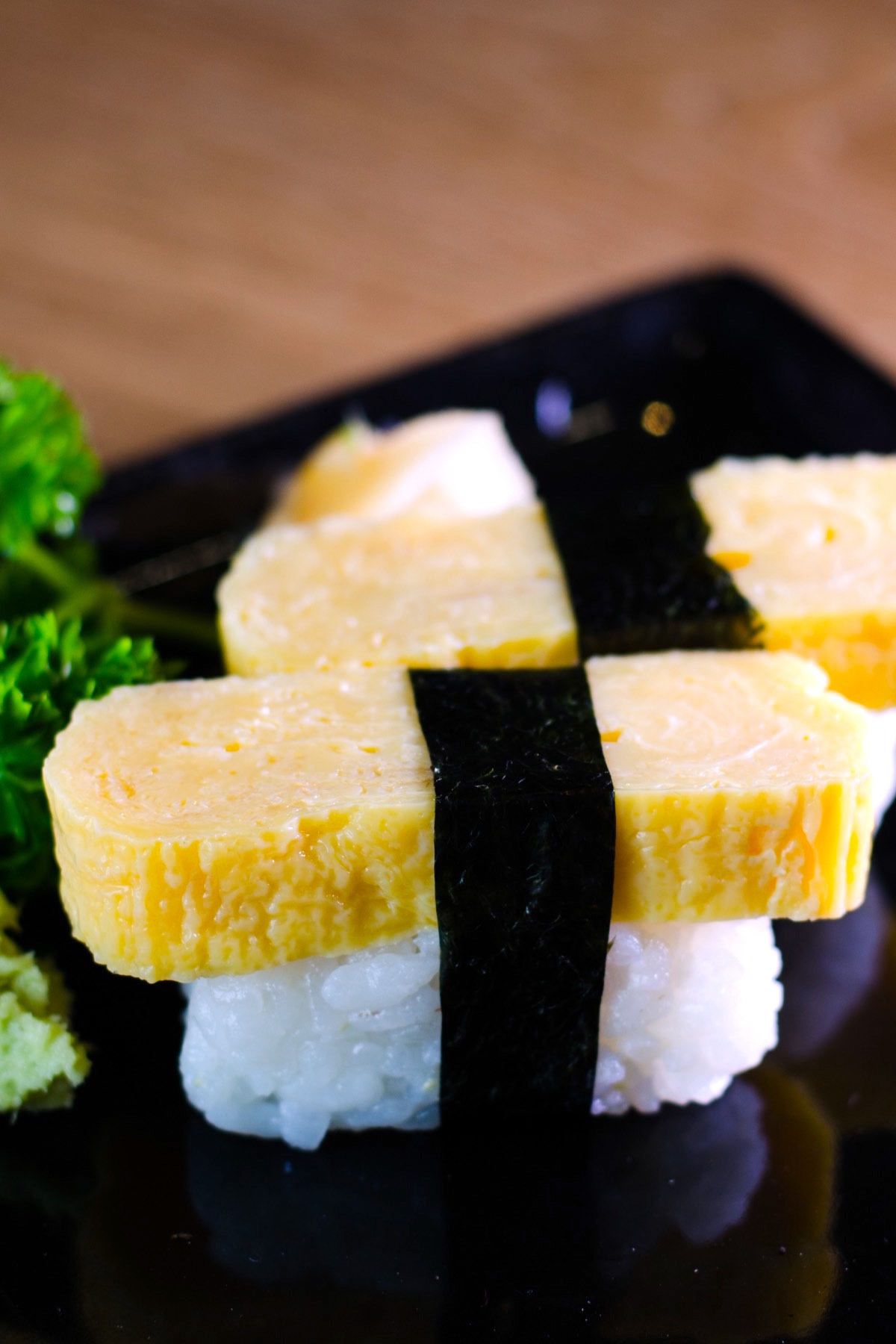
There’s no secret that we love Japanese sushi rolls. Sweet Potato Sushi Rolls, Salmon Nigiri, and this Tamago sushi are our favorites!
While sushi is often associated with fish, this egg-based sushi nigiri can be enjoyed by vegetarians or those who may not like traditional sushi made with raw fish. Tamagoyaki is made by creating several crepe-thin layers of egg and using a special technique to fold the layers into golden bars of deliciousness.
What is Tamago Sushi (Tamago Maki)?
Tamago sushi is made with the rolled egg omelet (tamagoyaki) and seasoned sushi rice. It’s usually rolled into a nigiri or sushi maki rolls.
When Japanese people refer to Tamagoyaki, they typically mean “rolled egg” or “rolled omelette”, though there are a few variations of tamagoyaki. In the most popular version, tamagoyaki is made by whisking eggs, sugar, mirin, rice vinegar, and seasonings. The eggs are cooked in thin layers which are rolled and folded together, then served on top of sushi rice. Many Japanese people use a specific rectangular Tamago pan for cooking tamagoyaki, but you can use the round frying pan you have at home.
Tamago Sushi Ingredients
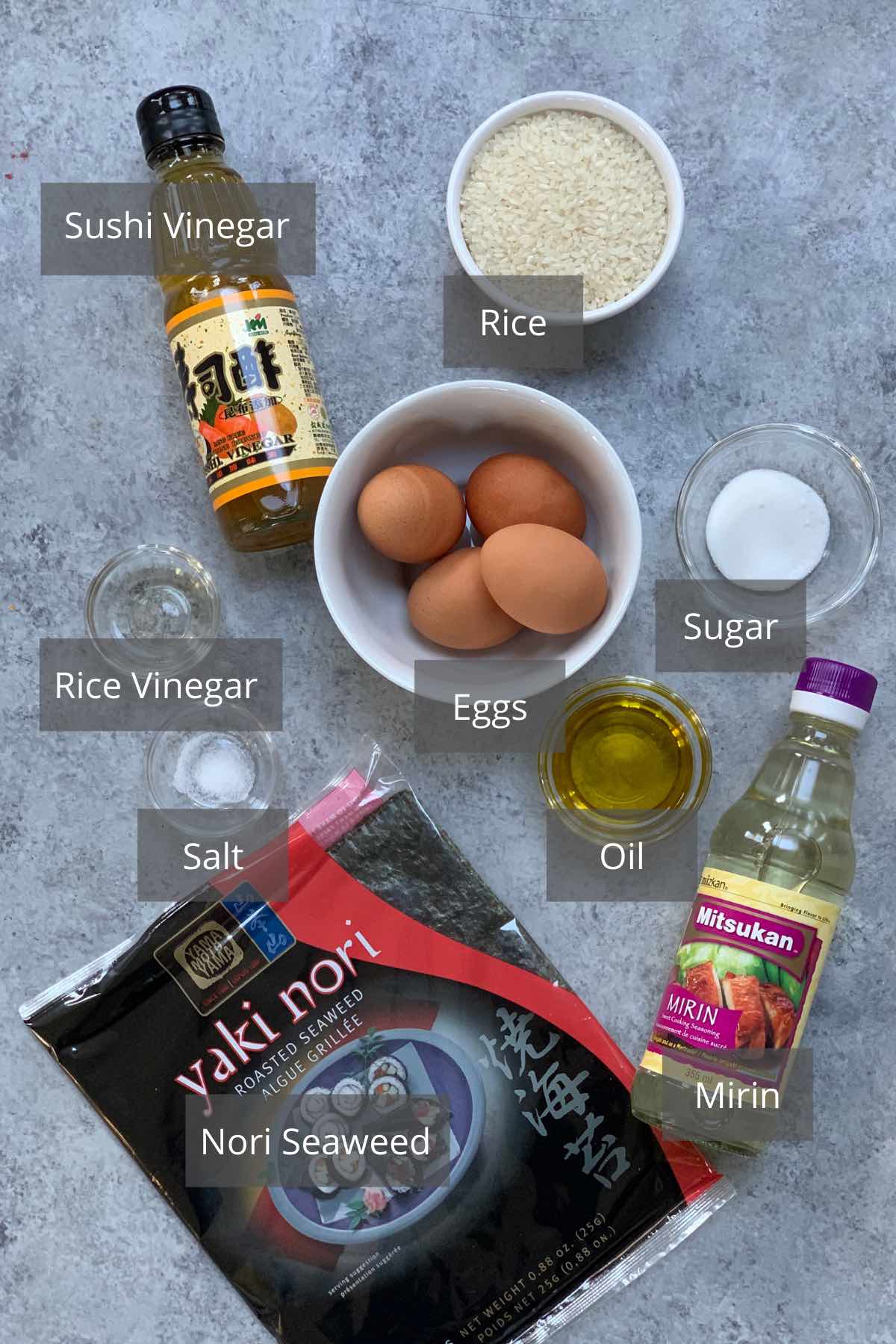
- Eggs: The star ingredient for this recipe. Avoid using old eggs.
- Sugar: Use regular granulated sugar.
- Mirin: An essential condiment in Japanese cuisine, Mirin adds a nice sweet flavor and tangy to the egg omelet. Substitute dry sherry if you prefer.
- Rice Vinegar: It adds a nice acidity to the Tamago and provides a lip-smacking zing. You can also use white vinegar.
- Salt: Adds savory flavor to the dish.
- Oil: You’ll need a decent amount of oil to prevent the omelet from sticking to the pan.
- Nori (Seaweed Sheets): The fresh nori sheet is crispy enough to easily break into half by folding it.
- Sushi Rice: Use high-quality Japanese short-grain sushi rice.
- Sushi vinegar: For seasoning the rice. If you don’t have sushi vinegar, you can mix together rice vinegar, sugar, and salt.
How to Make Tamago Sushi
Step 1: Cook Sushi Rice
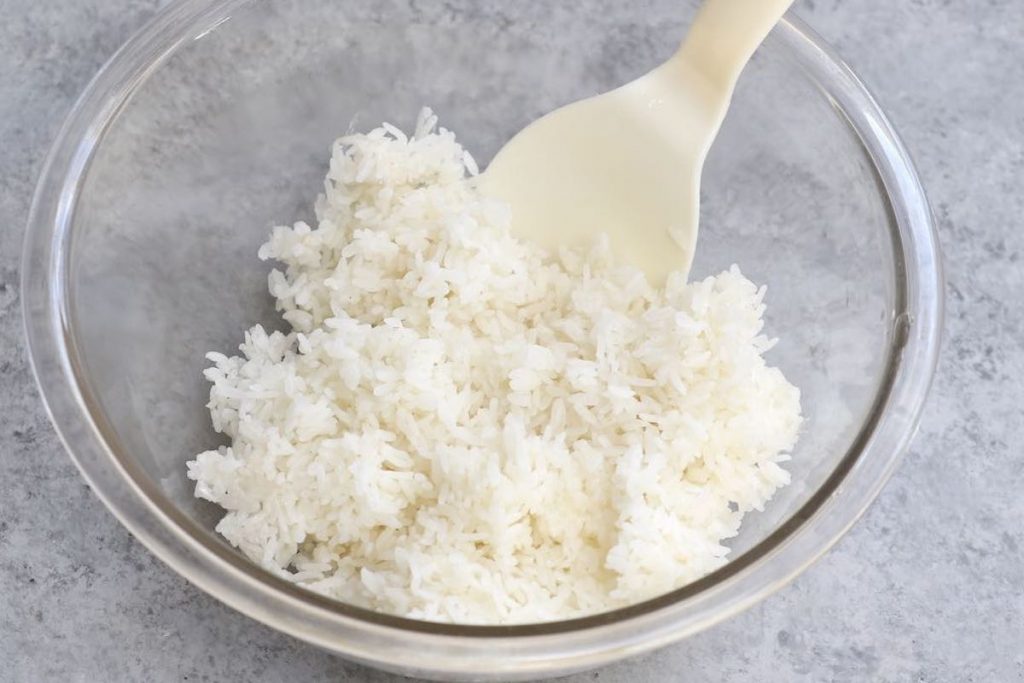
- Add the washed rice and water to the rice cooker, cooking according to instructions. Once cooked, transfer to a large bowl. When it’s still very warm (not too hot), stir in the sushi vinegar and mix.
Step 2: Make Tamagoyaki
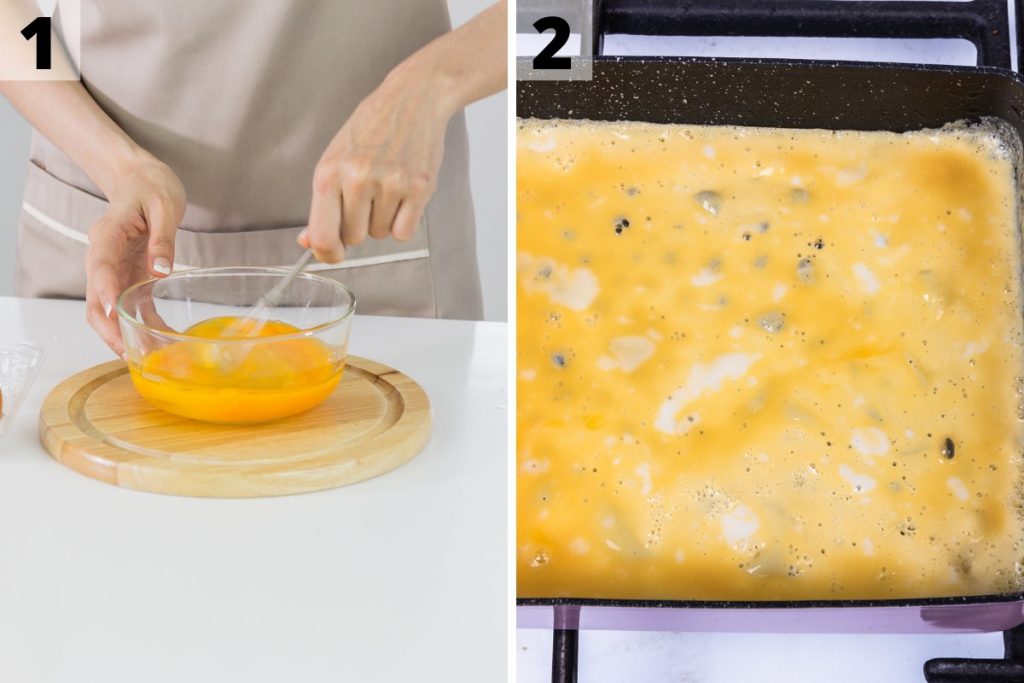
1. Beat the eggs in a bowl. In another bowl, whisk together water, rice vinegar, sugar and mirin until sugar is dissolved. Combine the egg mixture with the seasoning mixture.
2. Heat a rectangular tamagoyaki pan (you can also use a round pan, see recipe notes) over medium heat. Then dip a folded paper towel in oil, and apply to the pan. Once the oil is hot, pour a thin layer of the seasoned egg mixture in the pan. Tilt the pan to allow the liquid to flow to the edge of the pan.
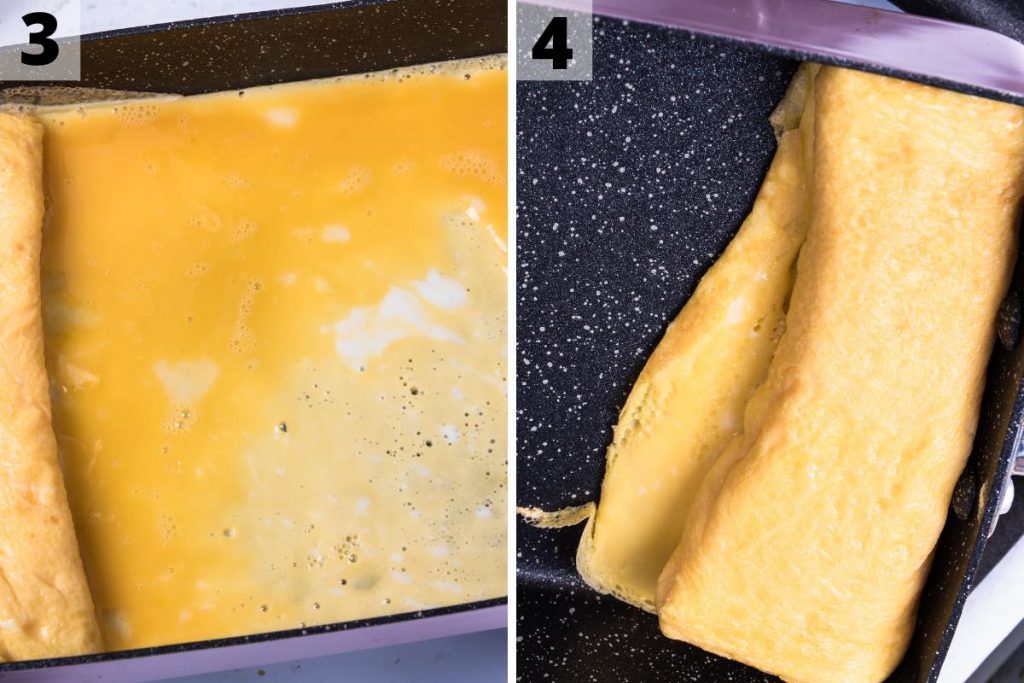
3. After the egg has set a little bit but still soft on the surface, start rolling it into a log shape. Add more oil and then pour another layer of egg mixture to cover the bottom of the pan.
4. When this new layer has set slightly and still soft on the top, start rolling the log back onto the set egg to the other end of the pan.
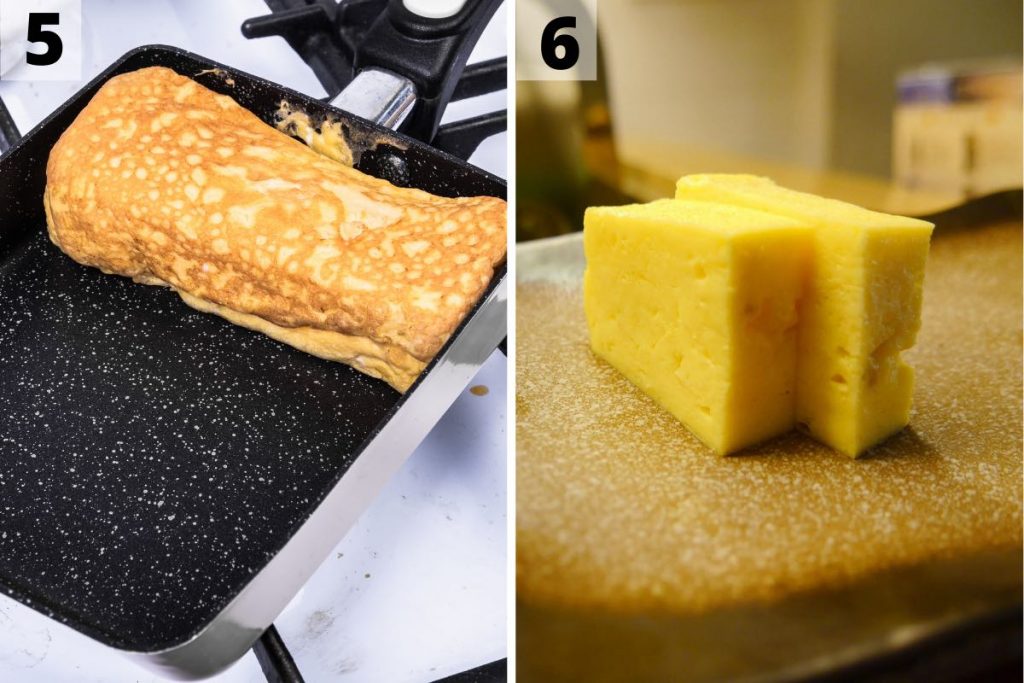
5. Repeat this process until you’ve used all the egg mixture.
6. Remove from the pan and place the tamagoyaki on a sushi mat. Wrap it up and shape the tamagoyaki when it’s still hot. Let it rest for about 5 minutes. Slice the tamagoyaki into 12 pieces, and set aside.
Step 3: Make Tamago Sushi Nigiri
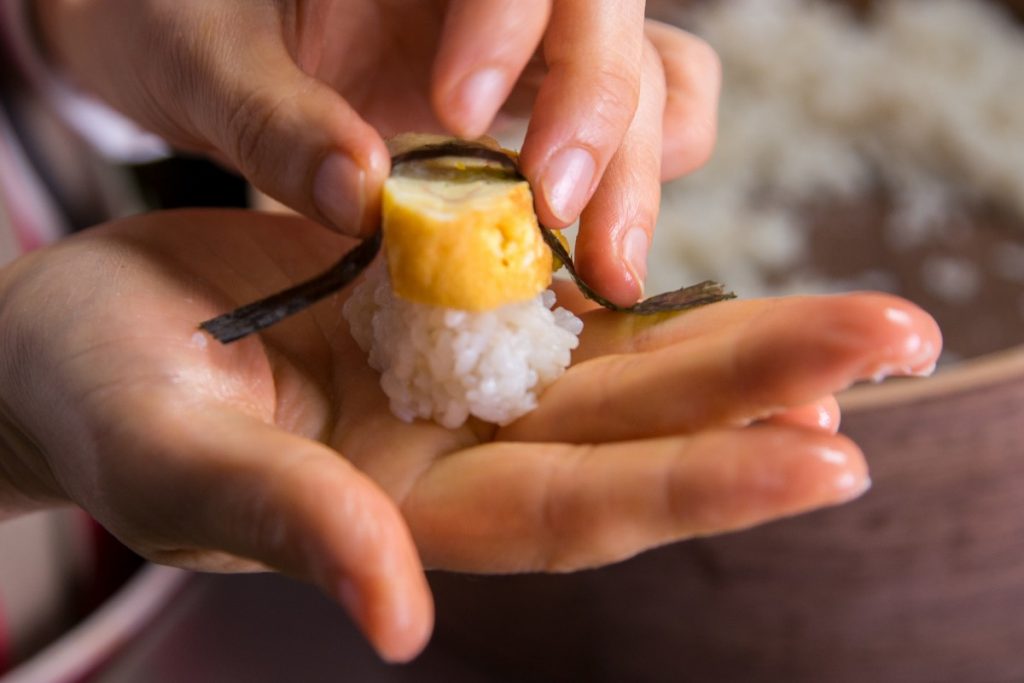
- Cut the nori seaweed into ¼-inch wide strips. Take 3/4 handful cooked rice and shape it to a long oval form.
- Place a piece of tamagoyaki on the rice, and then press it firmly to sick on the rice. Wrap the nori strip around the width of the sushi to secure the tamagoyaki to the rice. Place the assembled Tamago sushi on the plate. Serve and enjoy!
Tips & Tricks
- Use Tezu water (a mixture of water and vinegar) to wet your hands before handling sushi rice. This will help prevent the rice from sticking to your hands.
- Straining the egg mixture through a sieve makes the rolled egg extra fluffy.
- Make sure to coat the pan with enough oil before adding each layer of the egg mixture to prevent sticking.
- Make sure to roll the egg mixture before it’s fully settled, otherwise, the layers won’t combine properly.
- Let the cooked tamagoyaki cool down before cutting.
- Squeeze the rice firmly into an oval shape, but don’t squeeze too tight. It should still contain a little bit of air in the rice.
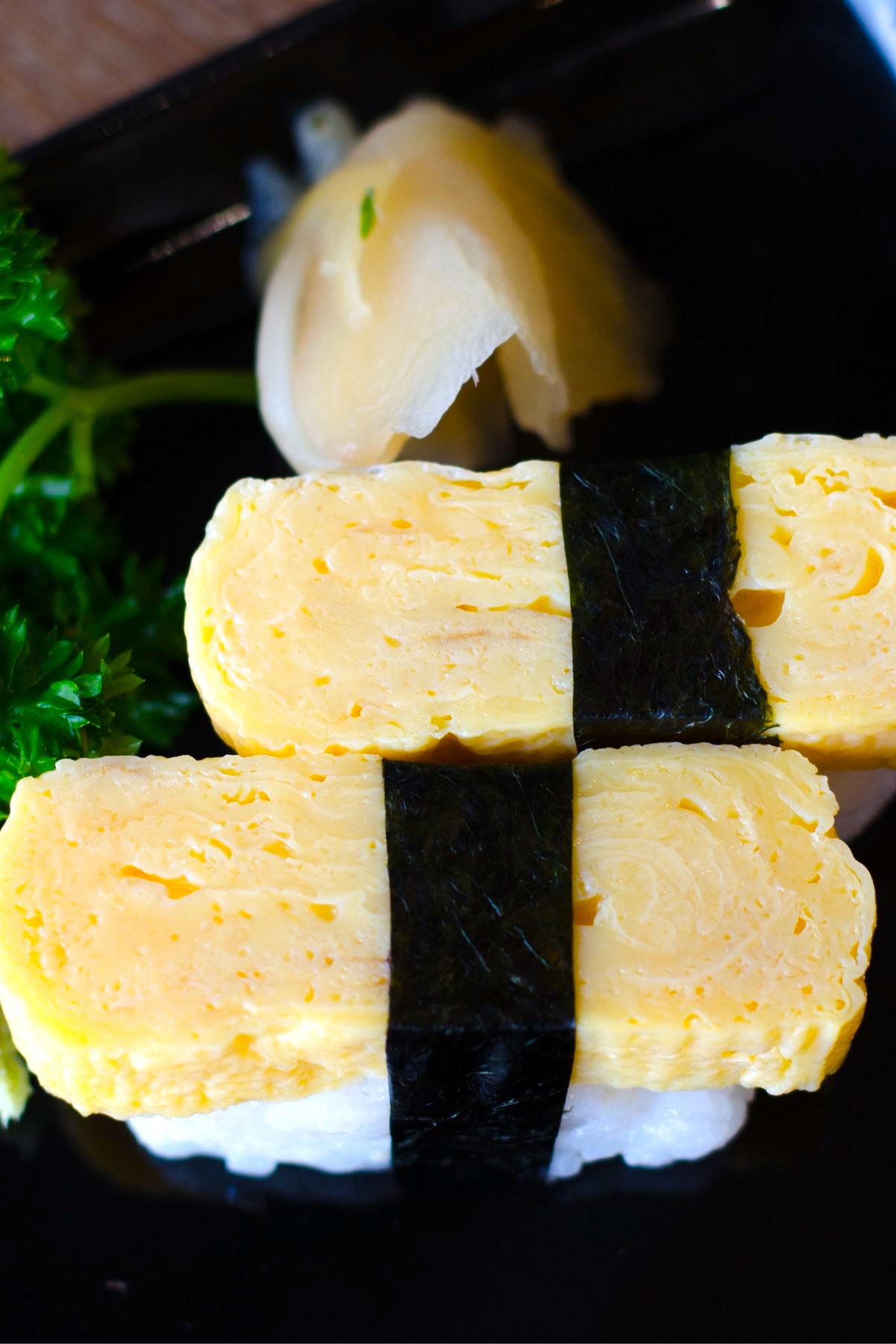
What Does Tamago Egg Sushi Taste Like?
Tamago Sushi tastes somewhat similar to the Western omelets but much sweeter. The addition of mirin and sugar give these omelets a unique, slightly sweet taste with a texture reminiscent of custard. This combination of sweet and savory makes Tamago egg sushi a treat for those who love complex flavors.
Can I Use a Round Frying Pan to Make Tamagoyaki?
Yes, you certainly can! While Tamagoyaki is traditionally prepared using a square or rectangular pan, a round frying pan will do just fine. There is no need to go out and get a new pan to make this dish, unless you really want to.
Just keep in mind that it will be flatter when your frying pan is bigger. It’s best to prepare Tamagoyaki in a non-stick pan, as the thin layers of the egg will lift right off the pan.

Atsuyaki Tamago vs Dashimaki Tamago
We mentioned that there are a few varieties of Tamagoyaki sushi. Two popular variations are Atsuyaki Tamago and Dashimaki Tamago. Each version uses slightly different ingredients and ratios, but the end results are very similar. Atsuyaki Tamago is thicker, firmer and denser than Tamagoyaki. Because the layers are thicker, it is easier to make and requires less dexterity.
Dashimaki Tamago is a rolled omelet that includes the ingredient dashi, a Japanese soup stock. This results in a heavier, heartier dish with a whole host of delicious flavors.
Does Tamago Sushi Have Fish?
Unlike most popular sushi dishes, Tamago sushi is not made with fish. It’s egg-based sushi and is ideal for vegetarians or people who prefer not to consume fish or raw fish.
Tomago Sushi Nigiri Variations
- Tamago Sushi Roll (Tamago Maki): Made by rolling sliced tamagoyaki in nori seaweed sheet and seasoned rice.
- Tamago Sashimi: When tamagoyaki is served alone without rice.
- Tamago Poke Bowl: Add sliced tamagoyaki, seaweed, avocado, etc. to a bowl of rice.
Is Tamagoyaki Vegetarian?
Vegetarians can enjoy tamagoyaki because there is no meat or fish. Tamago sushi is made using eggs, so ovo-vegetarians can add this traditional Japanese favorite to their diets.
If You Like This Recipe Try Out More Japanese Sushi Recipes
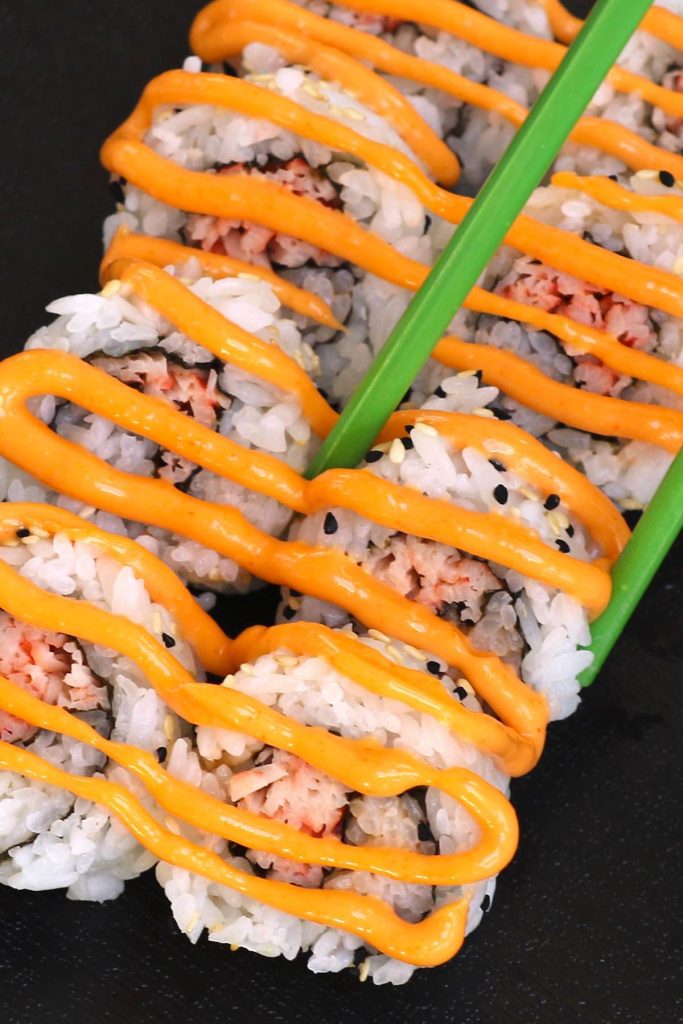
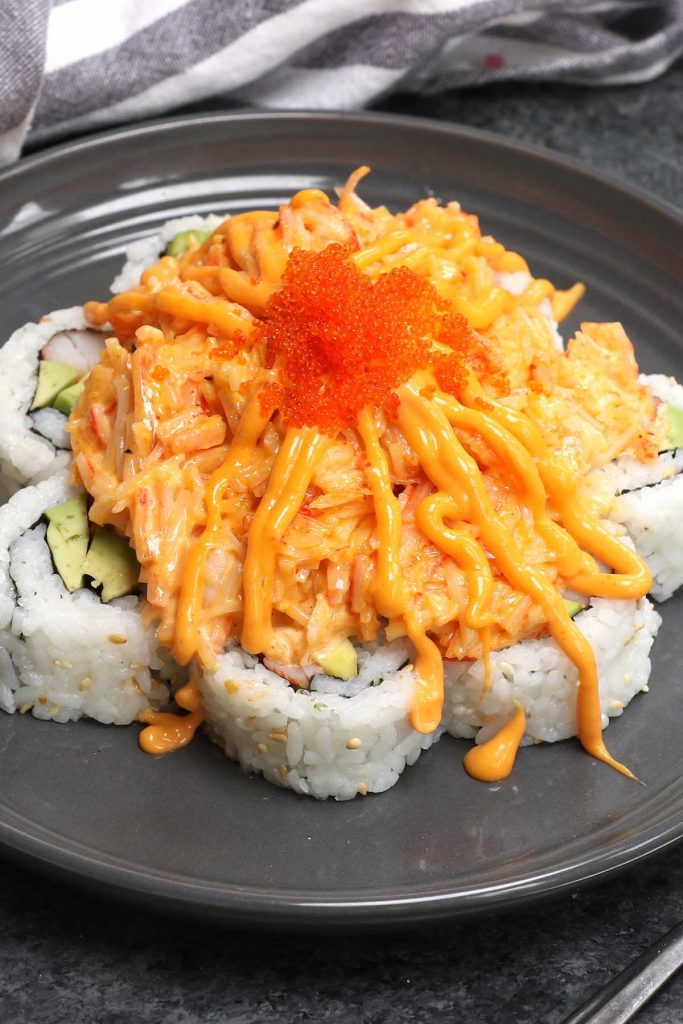
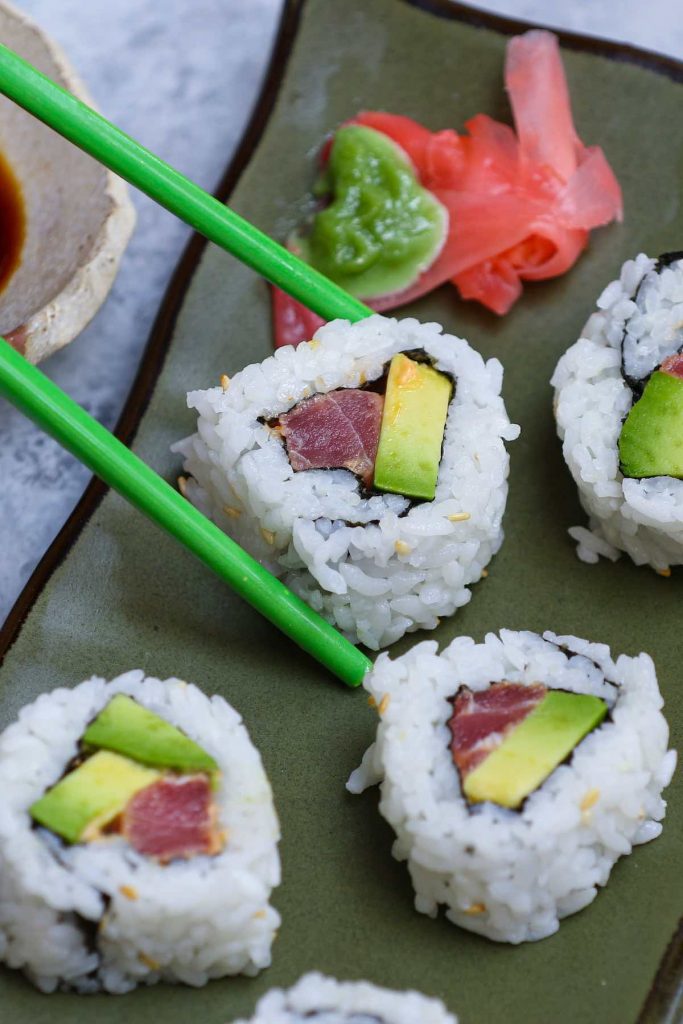
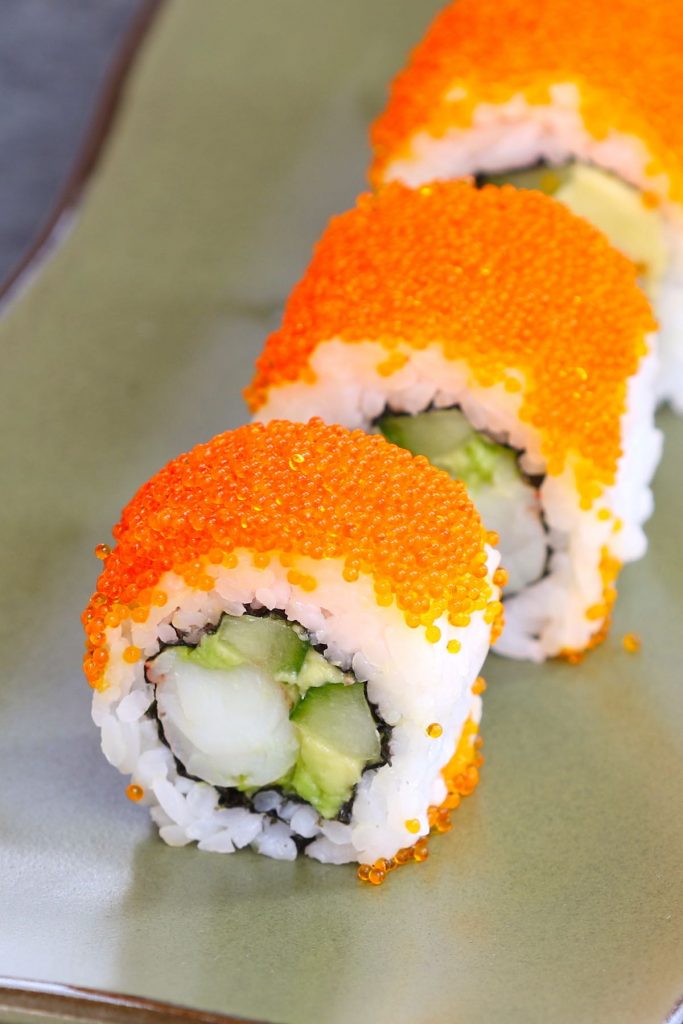
I hope you like this recipe. If you try it, please comment below and let me know how your Tamago Sushi turns out!
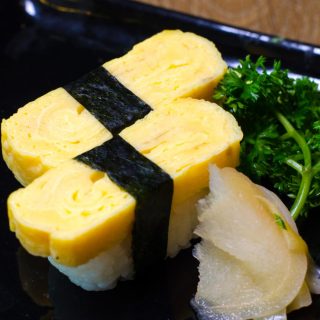
Tamago Sushi Recipe
Equipment
Ingredients
For the Sushi Rice
- 1 cup sushi rice, (uncooked short-grain sushi rice)
- 1 cup water
- 1 ½ tablespoons optional sushi vinegar, (or mixing 1 tablespoon rice vinegar, 1/2 tablespoon sugar)
For Tamagoyaki
- 4 eggs
- 2 tablespoon water
- 1/4 teaspoon rice vinegar
- 1 ½ tablespoon sugar
- 1 tablespoon mirin
- 1/4 teaspoon salt
- oil
Other
- nori
- optional soy sauce for serving
Instructions
Cook Sushi Rice
- Wash the rice and add it to the rice cooker together with water. Once cooked, transfer to a large bowl and let it cool down slightly. When it’s still very warm, stir in the sushi vinegar (or the mixture of rice vinegar, sugar, and salt).
Make Tamagoyaki for Sushi
- Beat the eggs in a bowl. Make sure not to over-beat the eggs.
- In another bowl, whisk together water, rice vinegar, sugar and mirin until sugar is dissolved.
- Combine the egg mixture with the seasoning mixture. Whisk gently. Strain the egg mixture through a sieve. Pour the mixture into a measuring cup or a jar with a spout and handle for easy pouring during cooking.
- Heat a rectangular tamagoyaki pan (you can also use a round pan, see notes*) over medium. Then dip a folded paper towel in oil, and apply to the pan.
- Once the oil is hot, pour a thin layer of the seasoned egg mixture into the pan. Tilt the pan to allow the liquid to flow to the edge of the pan.
- After the egg has set a little bit but still soft on the surface, start rolling it into a log shape. Make sure the egg is not cooked too much, otherwise, it won’t stick as you roll the log. (It’s fine if your eggs are not neatly folded).
- Move the rolled omelette to one side, and apply more oil to the pan with the paper towel. (Remember to apply the oil under the omelette.)
- Pour another layer of egg mixture cover the bottom of the pan. Lift the omelette to let the mixture run underneath.
- When this new layer has set slightly and still soft on the top, start rolling the log back onto the set egg to the other end of the pan.
- Repeat this process until you’ve used all the egg mixture.
- Remove from the pan and place the tamagoyaki on a sushi mat. Wrap it up and shape the tamagoyaki when it’s still hot. Let it rest for about 5 minutes.
- Slice the tamagoyaki into 12 pieces, and set aside.
Make Tamago Sushi
- Cut the nori seaweed into ¼-inch wide strips. Set aside.
- Take 3/4 handful cooked rice and shape it to a long oval form (about 1 ½ inche). Squeeze the rice gently and flatten the bottom. (You can dip your hands in vinegar water** to prevent sticking.)
- Place a piece of tamagoyaki on the rice, and then press it firmly to sick on the rice.
- Wrap the nori strip around the width of the sushi to secure the tamagoyaki to the rice. Repeat to make 12 pieces.
- Place the assembled Tamago sushi on the plate. Serve with optional soy sauce.
Notes
- * To make the tamagoyaki in a round pan, the process is the same as cooking in a rectangular pan. You’ll need to cut the edges in order to get an equal thickness.
- ** Tezu water for dipping hands: Mix together 1/4 cup water and 2 teaspoons rice vinegar.
- Straining the egg mixture through a sieve makes the rolled egg extra fluffy.
- The inner rolls of your omelet don’t need to look perfect. As the eggs are not fully settled when you roll it up, it’s normal the inner layers are not neatly lined up.
- Make sure to oil the pan with enough oil before adding each layer of the egg mixture so that the eggs are not sticking to your pan.
- Make sure to let the pan heat up before adding the egg mixture.
- Let the cooked tamagoyaki cool down before cutting.
Nutrition
Nutrition information provided is an estimate only and will vary based on ingredient brands and cooking methods used.
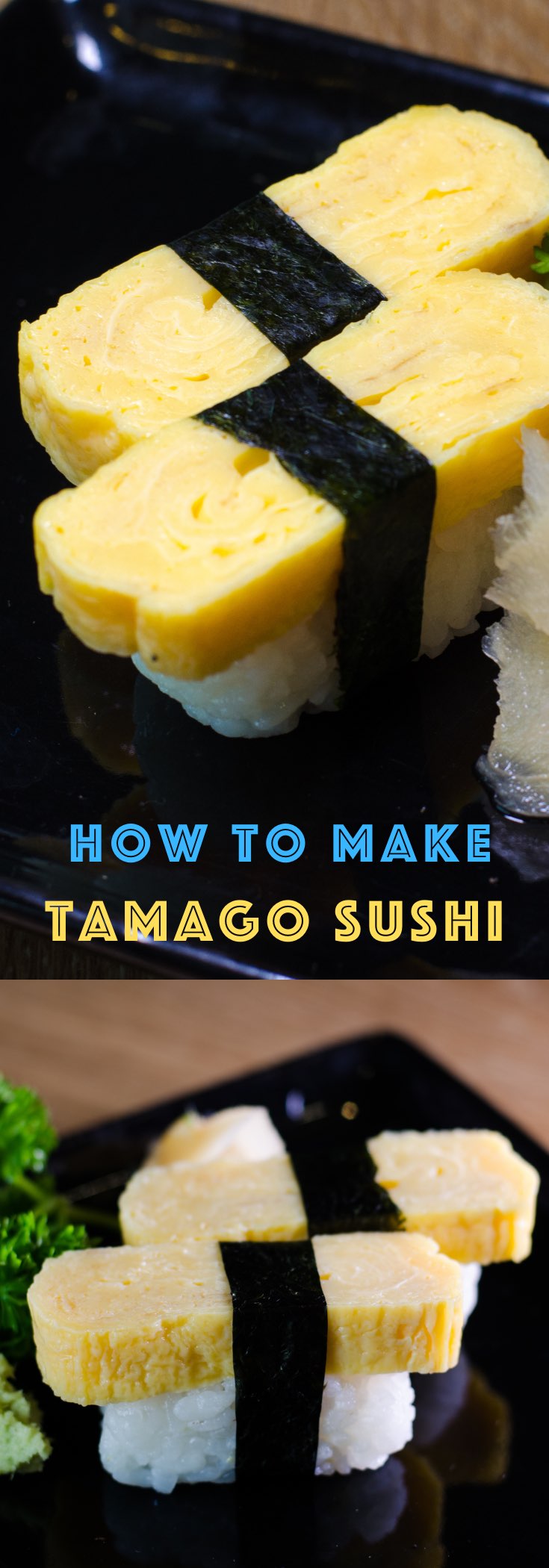
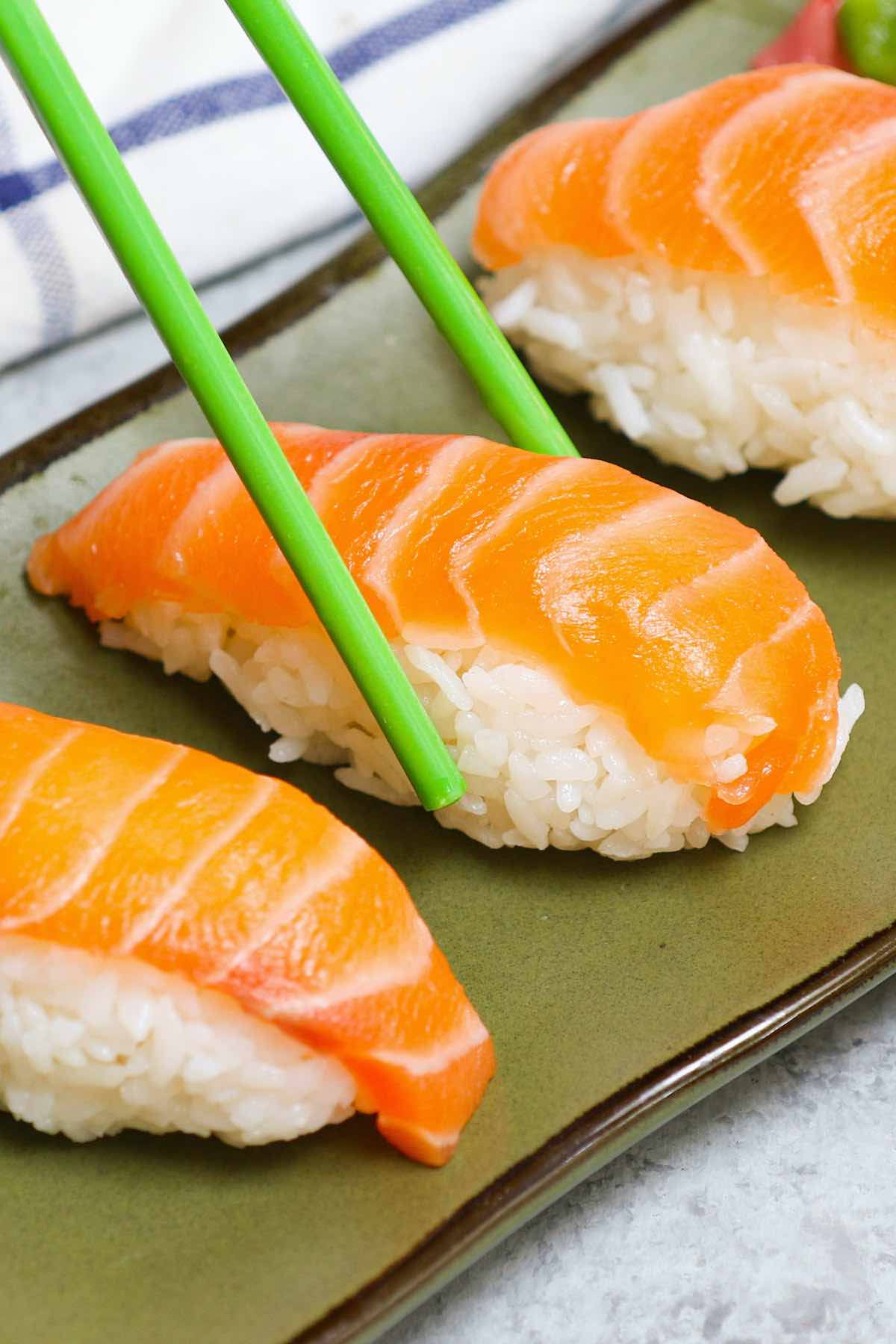


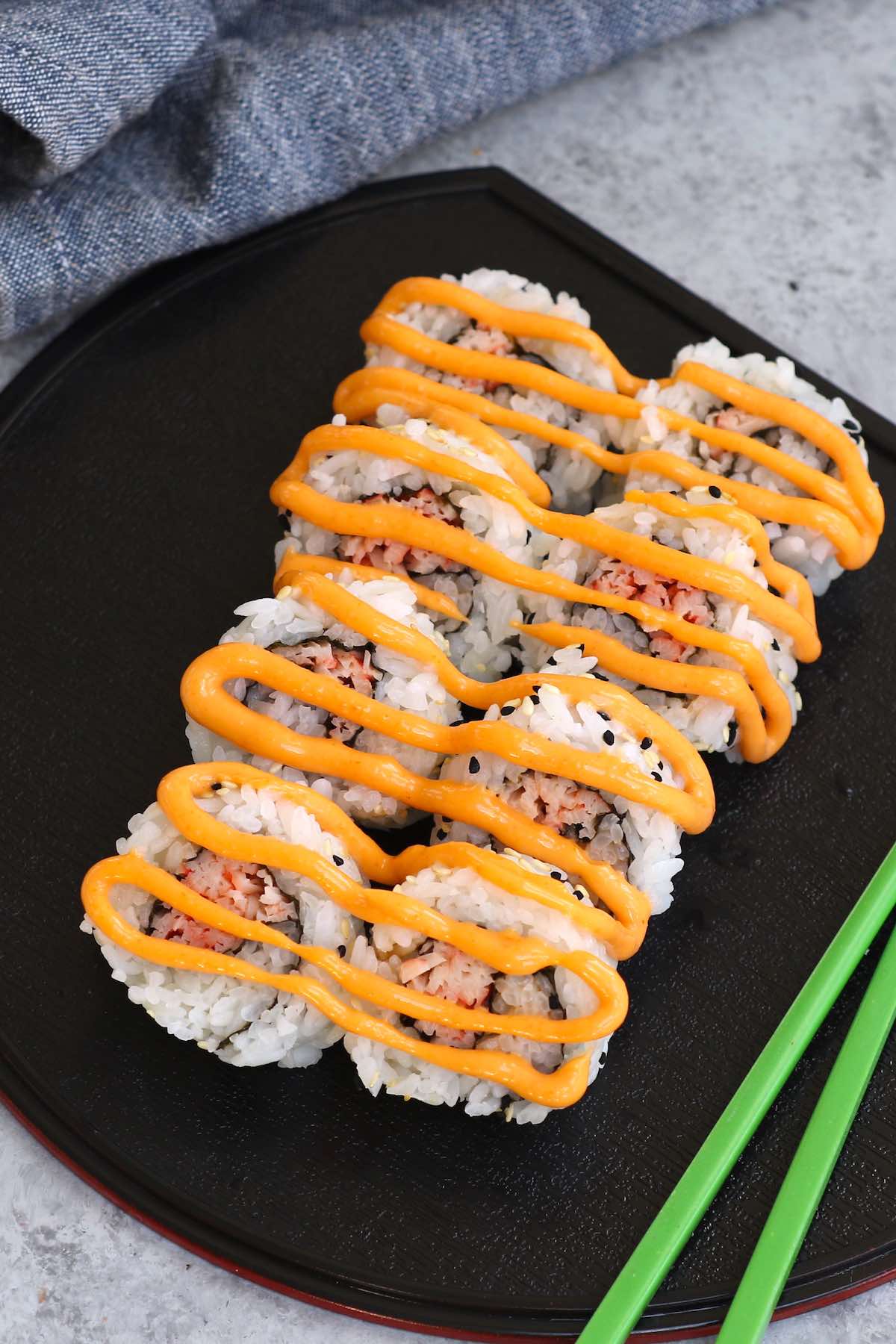
Is nutrition/serving size based on 12 pieces or just 2 pieces?